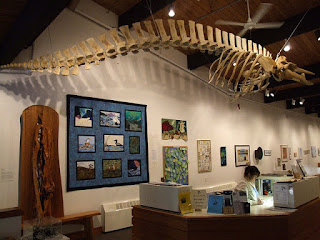Many communities built libraries and museums for their centennial projects, including Juneau, Ketchikan, Wrangell, Cordova, Petersburg, Kotzebue, Anchorage, Valdez, Homer, Kodiak, Nome, Fairbanks, and Bethel. In this way, the Alaska Purchase Centennial provided the foundation for the preservation and dissemination of Alaska's history around the state.
 |
| Kodiak used centennial funds to renovate a historic log building to house the Baranov Museum. Baranov Museum by J. Stephen Conn, CC BY-NC. |
 |
| Homer citizens built the Pratt Museum, a natural history museum, as their centennial project. Beaked whale by Travis, CC BY-NC. |
Nearly fifty years later, these institutions are showing their age, as weather, erosion, and neglect have taken their toll. Some of the centennial facilities proved completely unsustainable. The Kotzebue City Museum closed down in the late 1980s and the artifacts were scattered around to city offices and the traditional council. The museum at Fort Kenay was transferred to the Kenai Visitors and Cultural Center in 1991. The Yugtarvik Region Museum in Bethel was badly damaged by fire in June 1980. Others struggle to hang on despite major issues. On the coast, roofs of the centennial buildings have been particularly problematic. In Cordova, the ceiling is held together with Visqueen and duct tape, scant protection against wind and rain. At the Tongass Historical Museum in Ketchikan, the flat roof in the wettest place in Alaska soaks up moisture like a sponge, continuing to leak long after it stops raining outside. Former director Michael Naab noted, "It's like a wetland up there...There are actually small bushes and small trees on the roof."
Like the Alaska State Museum, many of the centennial libraries and museums are preparing to move into new, state-of-the-art facilities, or have moved in the past few years. The Seward Library joined forces with the Resurrection Bay Historical Society and moved into the new Seward Community Library & Museum in 2013. Ketchikan Public Library moved out of the Centennial Building in 2013, leaving the museum to renovate and expand into its vacated space. The Cordova Historical Museum and Library will move to the new Cordova Center this year. The Carrie McLain Museum, Nome Public Library, and regional non-profit Kawerak will move into the new Richard Foster Building in 2016. And the Alaska State Museum, Alaska State Library, Historical Collections, and Alaska State Archives will open as the Kashevaroff State Library, Archives, and Museum in the spring of 2016.
 |
| Artist's rendering of the Kashevaroff SLAM, opening spring 2016. |


